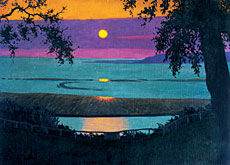A Swiss artist’s love of sunsets

Bern’s Fine Arts Museum is holding an exhibition entirely devoted to sunsets by the Swiss-born artist Félix Vallotton.
Sunsets were a recurring theme throughout the artist’s career and can be seen in his early woodcuts as well as his later landscape paintings.
The exhibition includes more than 60 paintings and 20 woodcuts by the post-impressionist artist.
It aims to show for the first time the importance of the sunset motif in Vallotton’s works.
Vallotton was born in Lausanne in 1865, but left for Paris at the age of 17 to study art at the Académie Julian, where contemporaries included Toulouse-Lautrec.
He subsequently spent spent much of his professional life in France and was later granted French citizenship.
But he took with him memories of the spellbinding landscapes and sunsets of Lake Geneva, which were to remain a source of inspiration throughout his life.
Woodcuts
The young artist first made a name for himself with his woodcuts and his modernist black and white illustrations.
His woodcuts, characterised by subtle lines and simple contrasts, helped make the art more popular.
“Vallotton has made such a great a contribution to wood engraving that he could, without regret, give up further ambitions to be a great painter,” wrote art critic Julius Meier-Graefe in 1898.
Fortunately, the Swiss artist decided to ignore this advice and from 1899 he devoted himself to painting.
Nabis
He was part of the influential Nabis (prophets) group of painters, whose members included Edouard Vuillard and Pierre Bonnard.
The group left a deep impression on the French art scene, due to the artists’ exploration of colour and composition. Subjects included landscapes and nudes as well as scenes of social realism.
However, the Nabis were also known for not exaggerating the importance of their subject matter.
“A picture, before being a horse, a nude woman, or some anecdote, is essentially a flat surface covered by colours in a certain order,” wrote painter Maurice Denis in 1890.
Vallotton shared this view, although he remained mainly on the fringes of the group. In fact, his friends referred to him as “le Nabis étranger” (the foreign Nabis) or “le très singulier Vallotton” (the distinctly individual Vallotton).
Abstract
He stayed faithful to these principles even when, in the early 1900s, he chose to adopt a more abstract technique known as “paysages composés” (composed landscapes).
“Starting from a sketch or a photograph, often produced several months earlier, he would recreate a landscape in his workshop, adapting it to incorporate his ideas on light and colour,” said Rudolf Koella, the exhibition’s curator.
The exhibition, which will later move on to the Gianadda Foundation in Martigny, displays 40 of the 44 sunsets painted by Vallotton throughout his career.
But it also includes works on other themes, such as the First World War, an event that deeply affected the artist.
War
This can been seen in “Landscapes of Ruins and Fires” in which Vallotton explores light in another way by painting bombings and explosions.
His sensitivity is also evident in “The Stabbed Man” or “Andromeda in Chains”, in which he expresses the horror of being in conflict with a powerful force.
Weakened both physically and mentally by the war, Vallotton turned back to painting landscapes and sunsets in his final years.
“The older I get, the more I am attracted by order and balance. I only want to express clear visions, with resources limited to light and shade, just as I choose,” he confided in his diary a few years before his death from cancer in 1925.
swissinfo, Armando Mombelli
1865: Félix Vallotton born in Lausanne.
1882: moves to Paris to attend the Académie Julian.
1885: first exhibition at the Salon des Artistes Français.
1891: begins producing woodcuts and illustrations.
1892: joins the Nabis.
1900: granted French nationality.
1914-18: paints the horrors of the First World War.
1925: dies of cancer.
“Sunsets” runs until February 20, 2005, at the Bern Fine Arts Museum.
The exhibition will be on show at the Gianadda Foundation in Martigny from March 18 to June 12, 2005.
Swiss artist Ferdinand Hodler was also inspired by Geneva sunsets, and an exhibition of his landscapes was held last year at the Zurich Kunsthaus.

In compliance with the JTI standards
More: SWI swissinfo.ch certified by the Journalism Trust Initiative











You can find an overview of ongoing debates with our journalists here . Please join us!
If you want to start a conversation about a topic raised in this article or want to report factual errors, email us at english@swissinfo.ch.